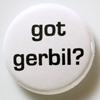

|
|||||
|
Home Pallid Gerbil Links Natural
History Captive
Husbandry To recommend a link please send an email. Pallid Gerbil Breeders To recommend a breeder please send an email. |
Pallid Gerbil
(Gerbillus perpallidus) Article By Russel Tofts Pallid Gerbils (Gerbillus perpallidus) are one of about 38 species of Northern Pygmy Gerbils (some authorities recognise up to 62 separate species but this is probably excessive). Smaller than the more familiar, and much more widely kept, Mongolian Gerbil, they share many of the same characteristics and habits, are inquisitive, active, and most reluctant to bite. They are sociable and can be kept in groups, but resent the sudden introduction of strangers, so any introductions should be done at a young age. Like all gerbils, they are expert burrowers and should be kept in an enclosure that allows such. Pallid Gerbils inhabit desert areas of north-western Egypt. Their large eyes instantly identify them as being strictly nocturnal, more so than many other gerbil species. Diet in captivity consists of a good quality gerbil mix, slices of apple or carrot and similar fresh food, and insects such as meal worms and locust hoppers. Beware of giving too many sunflower seeds or peanuts as these foods are very fattening to small rodents and, like a child’s predilection for sweets and chocolate, will often be consumed to the exclusion of all other items, leading to obesity, health problems, and poor breeding performance. Pallid Gerbils will breed all year round. The gestation period is 20-22 days. The litter size averages 4-5, but can be as many as 8 or more. Offspring are born naked, blind and helpless. Eyes open at 16-20 days but the young should not be removed from their parents until at least 4-5 weeks of age. A maximum longevity for this species has been recorded at just over 8 yaars, but this is probably exceptional, and 2-3 years is more likely. About The Author In 1997 I was appointed manager of the small animal department in a major pet superstore, with carte blanche over new developments within the department, a position I held for nearly three years during which time it boasted the largest and most comprehensive collection of small mammals to be found in any British pet shop. The following year I realised a lifelong ambition by seeing animals in their natural habitat in Africa, the subject of my first book, "Kenkay and Colobus - a tourist in ghana".. I am an active member of various zoological and conservation organisations including the Rodent & Lagomorph Taxon Advisory Group (TAG), the EEP for the Edward's Pheasant, Independent Zoo Enthusiasts' Society, National Association of Private Animal Keepers (NAPAK), and the Association of British Wild Animal Keepers (ABWAK). I have contributed articles to a variety of magazines, including the International Zoo News, and have appeared on television and radio. in 1999 I launched the Rodent Appreciation Group, for anyone interested in the Order Rodentia, particularly the rarer or more unusual species.
|
 Click to join EFExotics  Pins and magnets in the store! Pallid
Gerbil
Images
To submit genet images please send an email.
|
|||